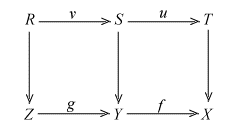In this section we recall some basic properties of strong monos in a category with pullbacks. Note that the notion of a strong mono is also defined for a general category (cf. Adamek, Herrlich and Strecker 1990] or [Borceux 1994 Vol I]). However, for our purpose the following simplified approach is sufficient.
Definition 1.1.1. (a) A strong
mono is a map such that any of its pullbacks is not non-isomorphic
epic.
(b) A regular mono
is a map which can be written as the equalizer of some pair of maps.
Proposition 1.1.2. (a) Any strong mono
is a mono.
(b) An epic strong mono is an isomorphism.
(c) Any pullback of a strong mono is a strong mono.
(d) Any composite of strong monos is a strong mono.
(e) Any intersection of strong monos is a strong mono.
Proof. (a) If f: Y --> X is not a mono then its
pullback along itself is a non-isomorphic epi (a retraction). Thus f
is not a strong mono.
(b) and (c) by definition.
(d) Suppose f: Y --> X and g: Z --> Y are
two strong monos. Suppose an epi w: R --> T is the pullback
of fg along a map t: T --> X. We have to prove that
w is an isomorphism. Let u: S --> T be the pullback
of f along t. Then w factors through u in a
map v: R --> S, and u is an epi because w is
so. Then u is an isomorphism as f is a strong mono. From
w = uv we conclude that v is an epi. But g is a strong
mono and v is a pullback of g. So v is also an isomorphism.
This shows that w = uv is an isomorphism.

Proposition 1.1.3. (a) Any pullback of regular mono is a regular mono.
(b) A map is not epic iff it factors through a non-isomorphic regular mono.
(c) Any regular mono is a strong mono.
(d) Any non-isomorphic strong mono factors through a non-isomorphic regular mono.
(e) A map is not epic iff it factors through a non-isomorphic strong mono.
Proof. (a) If u: U --> X is the equalizer
of a pair of maps (s, t): X --> Z and f: Y -->
X is any map then the pullback of u along f is the equalizer
of (sf, tf).
(b) A map f: Y --> X is not epic iff there is a pair
of different maps (s, t): X --> Z such that sf = tf
, in which case f factors through the equalizer of (s, t),
which is a non-isomorphic regular mono.
(c) A regular mono is not non-isomorphic epic by (b) and any pullback
of a regular mono is a regular mono by (a).
(d) follows from (b) as any non-isomorphic strong mono is not epic.
(e) follows from (b) - (d).
If a map f: Y --> X in a category is the composite m°e of an epi e: Y --> T followed by a strong (resp. regular) mono m: T --> X then the pair (e, m) is called an epi-strong-mono (resp. epi-reg-mono) factorization of f; the codomain T of e is called the strong (resp. regular) image of f. We say a category has epi-strong-mono (resp. epi-regular-mono) factorizations if any map has such a factorization.
Proposition 1.1.4. (a) Suppose
f: Y --> X is a map which is the composite of a map e:
Y --> U and a strong mono m: U --> X. Then e is
epic iff m is the smallest strong mono to X which f
factors through.
{b} Assume any composite of regular monos is regular. Suppose f:
Y --> X is a map which is the composite of a map e: Y -->
U and a regular mono m: U --> X. Then e is epic
iff m is the smallest regular mono to X which f factors
through.
{c} An epi-strong-mono (resp. epi-reg-mono) factorization of a map
is unique up to isomorphism.
Proof. (a) follows from (1.1.2.d) and (1.1.3.e);
(b) can be proved similarly using (1.1.3.b); (c) follows
form (a) and (b).
Proposition 1.1.5. Consider a category
A with pullbacks.
(a) A has epi-strong-mono factorizations
if any intersection of strong monos exists.
(b) A has epi-regular-mono factorizations
if the class of regular monos is closed under composition and intersection.
(c) A has epi-regular-mono factorizations
if any composite of regular monos is a regular mono and any map has a cokernel
pair.
(d) If A has epi-regular-mono factorizations
then any strong mono is regular.
Proof. (a) Any map f: Y --> X can be factored
as a map e: Y --> U followed by a mono m: U -->
X, where m is the intersection of all the strong monos in which
f can be factored through. Then m is a strong mono by (1.1.2.e)
and e is an epi by (1.1.4.a).
(b) Similar to (a).
(c) Any map f: Y --> X can be factored as a map e:
Y --> U followed by a regular mono m: U --> X, which
is the equalizer of the cokernel pair of f. Then m is the
smallest regular mono such that f factors through. Thus e
is epic by (1.1.4.b).
(d) follows from (1.1.4.c).